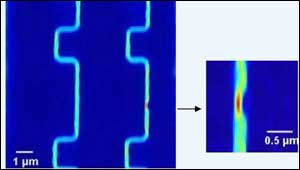Latest News

Does TV turn people off politics?
Television news programmes may be contributing to current political apathy, according to a new report funded by the Economic and Social Research Council. An in-depth study of more than 5600 TV news reports in both Britain and the US between September 2001 and February 2002 reveals that the news media may be encouraging a disengaged citizenry by representing the public as generally passive and apolitical.
“This study was prompted by growing concern about the poor and declining voter turnout

Two genes found to influence anorexia nervosa
Genes found on region of Chromosome 1 may regulate behaviors including eating and anxiety
Anorexia nervosa is a serious and potentially lethal illness. It is characterized by the relentless pursuit of thinness, the obsessive fear of gaining weight and emaciation. It commonly begins during adolescence in girls and it runs in families. A number of traits, such as perfectionism, anxiety and obsessionality, contribute to a risk to develop anorexia.
The authors used a process cal

WWF Italia tags urban ’hot spots’ with ESA’s UrbEx
WWF Italia is monitoring the urbanization of the Italian coast to catch overdeveloped “hot spots”, courtesy of an ESA programme to develop new applications-driven services with space data.
WWF Italia has been working with ESA as part of the Agency’s Urban Expansion (UrbEx) project to provide a novel information service that monitors the loss of natural areas from urban development. The project’s objective was to demonstrate the capability to monitor urban growth using Earth observa

A lead in the rapid production of "intelligent" antibodies for diagnostic purposes
Because they are able to recognize a particular cell marker — a protein — antibodies are generally used to identify abnormal cells in the body. As such, they play a key role in diagnosis, treatment and basic research.
At the Institut Curie, CNRS research scientists have recently prepared a new type of antibody which for the first time combines several crucial features: it can be produced in a few days, it can be expressed directly in cells, and it is, moreover, sensitive to the shape of pro

New sensor bares faults in smallest possible, most advanced circuits
A new scanning microscope developed at Brown University can uncover defects in the smallest and most complex integrated circuits at a resolution 1,000 times greater than current technology. The scanner removes a barrier to further shrinking of integrated circuits: As circuits get smaller, non-visual defects become harder to find.
“This microscope will allow manufacturers to find defects in each embedded wire in ever-tinier circuits,” said Brown University professor Gang Xiao. He developed th

Math discovery may aid resource management
With the aid of a chance discovery by a graduate student, scientists from Oregon State University have identified, dusted off and found a new use for an old math theory from the early 1800s that could revolutionize the management of lands, protection of species and study of ecology.
The discovery promises for the first time to address the enormous complexities of the natural world with the powerful tools of advanced mathematics – which, until now, have been of limited use in the study of man











